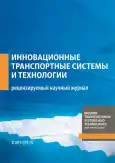Options for the structure of an autonomous electric power system with a battery of hydrogen fuel cells
- Authors: Karabadzhak I.D.1, Nikitin V.V.1
-
Affiliations:
- Emperor Alexander I St. Petersburg State Transport University
- Issue: Vol 10, No 1 (2024)
- Pages: 59-75
- Section: Original studies
- URL: https://journal-vniispk.ru/transj/article/view/254562
- DOI: https://doi.org/10.17816/transsyst624890
- ID: 254562
Cite item
Full Text
Abstract
Background. Recently, interest in the problem of reducing the emissions of hydrocarbon fuel combustion products into the atmosphere and the use of alternative and renewable energy sources has sharply increased. This problem is relevant to both stationary and transport energy. One of the ways to reduce the harmful impact of primary energy sources in autonomous transport power plants on the environment is their hybridization, i.e., use, along with traditional energy sources (turbogenerators and diesel generators), of hydrogen sources of electricity (fuel cell batteries).
Aim. This study presents a justification of the optimal variant of the structure of an autonomous electric power system with a combined power plant based on hydrogen sources of electricity.
Materials and Methods. To achieve this goal, a comparative analysis of the parameters and characteristics of the power system elements was performed, as well as a method for modeling processes in the power system under study using the MATLAB Simulink package. Two options for the structure of an autonomous electric power system are being considered, namely, a common AC and DC bus. An analysis of the parameters and characteristics of these options was performed for three typical operating modes, namely, turning on a static load, direct starting of an asynchronous motor with a load on the shaft, and transferring consumers from power from a diesel generator to power from a battery of hydrogen fuel cells.
Results. In all considered modes, the VTE battery is characterized by a rapid response to load changes and stable efficiency. The nature of transient processes is aperiodic or low oscillatory, rapidly decaying. In terms of the number of semiconductor converters, filtering devices, and their total power, the structure of an autonomous power system with a common AC bus is more preferable.
Full Text
##article.viewOnOriginalSite##About the authors
Ivan D. Karabadzhak
Emperor Alexander I St. Petersburg State Transport University
Author for correspondence.
Email: iwan.karabajack@yandex.ru
SPIN-code: 4353-5098
engineer, post-graduate student
Russian Federation, St. PetersburgVictor V. Nikitin
Emperor Alexander I St. Petersburg State Transport University
Email: pgups.emks@mail.ru
ORCID iD: 0000-0002-5699-0424
SPIN-code: 6864-5678
Dr. Sci (Tech.), Associate Professor
Russian Federation, St. PetersburgReferences
- Shnipova AI. Development of hydrogen energy in Russia: a new energy policy. Energy of Unified Grid. 2022;62(1):58–69. [cited: 13.12.2023] Available from: https://энергия-единой-сети.рф/annotatsii-nomerov/1-62-2022/
- Tezuka K. 20 Years of Railway Technical Research Institute. Japan Railway & Transport Review. 2007;47(3):9–15. [cited: 13.12.2023] Available from: https://www.ejrcf.or.jp/jrtr/jrtr47/pdf/f09_Tez.pdf
- The Fuel Cell Industry Review, 2021. [internet] [cited 13 Dec. 2023] Available from: https://fuelcellindustryreview.com
- Klebsch W, Guckes N, Heininger P. Evaluation of climate-neutral alternatives to diesel multiple units. Economic viability assessment based on the example of the Düren network. June, 2020. [cited: 13.12.2023] Available from: https://www.vde.com/resource/blob/2068330/
- Ogawa K, Yoneyama T, Sudo T, et al. Performance Improvement of Fuel Cell Hybrid Powered Test Railway Vehicle. Quarterly Report of RTRI. 2021;62(1):16–21. doi: 10.2219/rtriqr.62.1_16
- Kasatkin MA, Landgraf IK. Perspektivy vodorodnyh energoustanovok na toplivnyh elementah dlya razvitiya elektrotransporta. Transport of Russian Federation. 2019;6(85):46–49 (In Russ.) [cited: 13.12.2023] Available from: https://www.elibrary.ru/download/elibrary_42194760_27245461.pdf EDN: TBTUPX
- Karasev D. Vodorodnaya i akkumuliatornaya tyaga: proekty TMH. (In Russ.) [cited: 13.12.2023] Available from: https://tmholding.ru/media/article/7135.html
- Dugin GS, Grigoriev SA. New possibilities for fuel cells application on the transport means. Alternative Fuel Transport. 2010;2(14):76–78. [cited: 13.12.2023] Available from: https://ngvrus.ru/file/journal-history/tat-2-2010-preview.pdf EDN: MBWLIZ
- Study of Hydrogen Fuel Cell Technology for Rail Propulsion and Review of Relevant Industry Standards. № DOT/FRA/ORD-21/20. Washington: Federal Railroad Administration, 2021. [cited: 13.12.2023] Available from: https://railroads.dot.gov/sites/fra.dot.gov/files/2021-06/Study%20of%20Hydrogen%20Fuel%20Cell%20Tech.pdf
- Lapidus BM. Improvements in energy efficiency and the potential use of hydrogen fuel cells in railway transport. The Russian Railway Science Journal. 2019;5: 274–283. (In Russ.) doi: 10.21780/2223-9731-2019-78-5-274-283
- Kim KK, Tkachuk AA. The three-phase transformer with stabilizing properties. Electronics and electrical equipment of transport. 2016;5:18–21. (In Russ.) [cited: 13.12.2023] Available from: http://eet-journal.ru/upload/iblock/336/6j1cafwyohyzloe8qniupvrhzuwsa2z9.pdf
- Asabin V, Garanin M, Kurmanova L, et al. Prospects for using hydrogen on railway transport. IOP Conf. Ser.: Mater. Sci. Eng. 2020;953:012074. doi: 10.1088/1757-899X/953/1/012074
- Baiko AV, Nikitin VV, Sereda EG. Hydrogen energy sources with current inverters in ship AC power plants. Russian Electrical Engineering. 2017;6(88):355–360. doi: 10.3103/S1068371217060037
- Nikitin VV, Marikin AN, Tret’yakov AV. Generator cars with hybrid power plants. Russian Electrical Engineering. 2016;5(87):260–265. doi: 10.3103/S1068371216050138
- Kim KK, Panychev AYu, Blazhko LS. Innovative Energy Sources for Hyperloop High-Speed Transport. BRICS Transport. 2022;1(1):1–10. doi: 10.46684/2022.1.1
Supplementary files












